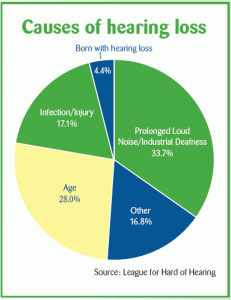
I recently came across statistics related to Deafness and hearing loss. These were compiled by the National Institute on Deafness and Other Communication Disorders (NIDCD). I found a few to be surprising. For instance, “9 out of 10 children who are born deaf are born to parents who can hear’. Why did I assume that a greater percentage of deaf babies were born to deaf parents?
Additional findings: (as of 2010)
- Men are more likely to experience hearing loss than women.
- Of adults ages 65 and older in the United States, 12.3 percent of men and nearly 14 percent of women are affected by tinnitus. Tinnitus is identified more frequently in white individuals and the prevalence of tinnitus is almost twice as frequent in the South as in the Northeast.
- Approximately 17 percent (36 million) of American adults report some degree of hearing loss.
- There is a strong relationship between age and reported hearing loss: 18 percent of American adults 45-64 years old, 30 percent of adults 65-74 years old, and 47 percent of adults 75 years old or older have a hearing loss.
- About 2 to 3 out of every 1,000 children in the United States are born deaf or hard-of-hearing. Nine out of every 10 children who are born deaf are born to parents who can hear.
- The NIDCD estimates that approximately 15 percent (26 million) of Americans between the ages of 20 and 69 have high frequency hearing loss due to exposure to loud sounds or noise at work or in leisure activities.
- Only 1 out of 5 people who could benefit from a hearing aid actually wears one.
- Three out of 4 children experience ear infection (otitis media) by the time they are 3 years old.
- Roughly 25 million Americans have experienced tinnitus.
- Approximately 188,000 people worldwide have received cochlear implants. In the United States, roughly 41,500 adults and 25,500 children have received them.
- Approximately 4,000 new cases of sudden deafness occur each year in the United States. Hearing loss affects only 1 ear in 9 out of 10 people who experience sudden deafness. Only 10 to 15 percent of patients with sudden deafness know what caused their loss.
- Approximately 615,000 individuals have been diagnosed with Ménière’s disease in the United States. Another 45,500 are newly diagnosed each year.
- Approximately 3 to 6 percent of all deaf children and perhaps another 3 to 6 percent of hard-of-hearing children have Usher syndrome. In developed countries such as the United States, about 4 babies in every 100,000 births have Usher syndrome.
- One out of every 100,000 individuals per year develops an acoustic neuroma (vestibular schwannoma – a slow-growing benign tumor on the nerve that connects the ear to the brain).
Not long ago, I overheard a commentary noting how none of us are truly “black” or “white”, but really varying shades of brown and other colors. In terms of “culture” , the boundary lines between “hearing” and “deaf” can be more clearly seen as we usually affiliate with one or the other. Maybe the line between “hearing” and “deaf” becomes more cloudy as many of us truly fall somewhere in-between on the full spectrum.












April 28, 2014
asl, cochlear implants, deaf, Deaf Culture, hearing loss, Meniere's disease, Tinnitus